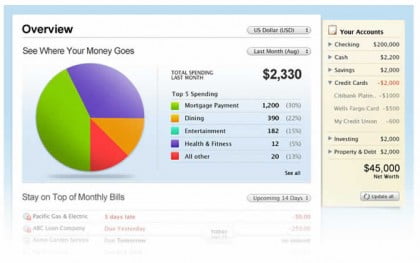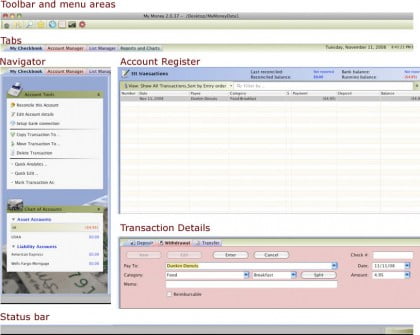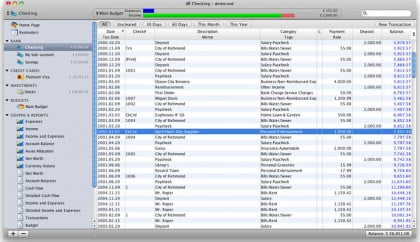Manage your money on your Mac. Sounds like a great idea, right? But which Mac financial software does what? And, whatever happened to Intuit’s popular Quicken?
If you’ve been a Mac user for awhile, or switched to a Mac from Windows, then you know about the ongoing love-hate affair with Quicken. Mac users have been ignored by Intuit for years, and suffered through buggy and infrequent Quicken updates. If not Quicken, what? Here’s my Top 10 Best Mac Money Apps To Replace Quicken.
Why Not Quicken?
Intuit’s Quicken is arguably the most popular personal and business software for Mac and Windows PC users.
What’s not to like? Not much, if you’re running Windows on your Mac. The last version of Quicken for Mac users dates back to 2007.
Quicken Essentials for Mac is due to go on sale in February. As usual, Quicken Essentials will be loaded with features, yet will fall far short of the feature set of the various Quicken versions for Windows.
Feature parity between Mac and Windows versions of Quicken seems to be a strategy that died a decade ago, back when Intuit may have hoped or expected the Mac to die—but it didn’t. Since then, the Mac has flourished, users abound, sales are at record levels, market share is up, yet Intuit’s policy with Quicken for Mac seems to be one of benign neglect, despite the focus recently on eye candy.

Worse, Mac users who stuck with Quicken through the years have been treated to buggy software and infrequent updates. Is there an alternative to Quicken for Mac users? The answer is yes. Mac users have many financial and money management alternatives.
Sticking It To The Mac, Man
Quicken Essentials for Mac (2010) looks to be loaded with features. Yet Intuit warns that some features—advanced investment performance reports and other features—are not in the new version, and advises users who need them to keep using Quicken Mac 2007.
See? That’s how Intuit treats Mac users. How about exporting data to TurboTax? Nope. The new Quicken Essentials won’t do that, either. Intuit says to stick with Quicken Mac 2007 instead.
How about bill paying? Surely Quicken Essentials for Mac will have that, right?
Uh, nope. Try Quicken Mac 2007 instead. Or, Quicken Bill Pay. What does the latest Quicken version do for Mac users?
It’ll import data from Quicken Mac 2005, 2006, 2007, and converts Quicken Windows 2007, 2008, and 2009. The newest version of Quick for Mac only supports Intel Macs, and only Mac OS X Leopard and Snow Leopard. PowerPC Macs running Tiger need not apply.
They’re in reverse order, starting with the least expensive (free) fewest features, and ending with the top two feature laden apps. All are less expensive than the $69 retail price tag on Quicken Essentials for Mac (2010; discounts available for pre-order). They’re available for download now, receive frequent updates, and somewhere in this group is bound to be a money manager you can use to replace Quicken.
How many Mac apps are there to manage your Money? Plenty. But not all are as complex or expensive as Quicken Essentials. A few help Mac users manage a checkbook. A few others manage investments. One runs on Mac or Windows PC or various flavors of Linux. And it’s free.
#10 – Buddi
If the Mac is the computer for the rest of us, then Buddi is the personal budget software for the rest of us. Buddi is free and aimed primarily at users with little or no financial background.
Start Buddi by setting up accounts. Checking or savings or credit card. That’s where your money stays and goes (in and out).
Buddi also defines some specific budget categories, including Salary, Utilities, Rent, and so on. You can edit or add more. That’s where money goes (just out).
After that, you’ll set up a simple Budget (how much you need to spend, based on your income), and just enter your transactions and Buddi takes care of the rest. Select the amount you spent, select a matching category.

Buddi tracks your transactions and spits out a few reports, including income and expense totals, as well as by Category. If all you have is a single checking account and a need to know where the money went, Buddi is fine.
Buddi also gives you a little room to grow—add more accounts and categories, including scheduled transactions (so you don’t have to remember). Still, Buddi might seem complex to some Mac users. In that case, simple is even better than free.
#9 – CheckBook
One of the very first apps I tried after Quicken was CheckBook. It’s what you think it is. If you can handle a checkbook, you’ll be right at home with CheckBook.
This Mac app is inexpensive and easy to use. All your transactions—income or expense—are in one window so it’s easy to see where the money came from and where it went.

Like most money apps, CheckBook lets you set up multiple accounts and categories. You enter the transactions checkbook style. But features abound. Transfer amounts between accounts. Import data from Quicken or other money apps. Even manage multiple currencies.
CheckBook Pro adds a few more features, including smart folders, global account summary reports, and scheduled entry reminders. But if all you need is a good digital checkbook, CheckBook is about as easy as it gets.
#8 – EasyMoney
Still on the easy list is EasyMoney. While not as easy as CheckBook, it follows the same path of simplicity, but with a few more goodies.
EasyMoney segregates financial functions. Accounts. Expenses. Revenue. Transactions. Each has a separate window so you can see where money is, where it came from, where it went.

You won’t be overwhelmed by features, and the EasyMoney window—more complex than CheckBook—is still self explanatory. Accounts in the left column, transactions in the center column, and an easily understood toolbar at the top to add, delete, edit, transactions and accounts.
#7 – Cha-Ching
One of my early favorites as a replacement for Quicken is the cute and sassy Cha-Ching.
First, Cha-Ching works in a familiar manner. Set up accounts, set up categories, set up transactions.
But Cha-Ching also lets you sync with iCal so you can be reminded when to pay certain bills. Recurring expenses can be set up according to a schedule.
And, Cha-Ching has a single window that gives you quick access to every function from bills to payments to budgets. Importantly, there’s a Cha-Ching version available for your iPhone which syncs via WiFi to your Mac, so you can manage and track transactions when you’re away from your Mac.
Those are the easy and inexpensive money manager Apps for the Mac.
How we manage our money is a personal thing, and varies greatly from one Mac user to another. Some keep it simple. Others have more involved and complex requirements. From shoebox to double entry accounting and online management, Mac money management apps run the spectrum.
#6 – My Money
The first of the more complex and more capable Mac apps on my list is My Money. This is not your father’s digital checkbook.
My Money works with your bank’s online statements.
Transactions can be downloaded from your bank and are automatically entered into My Money on your Mac.
My Money does a few things I really like, but comes with a level of complexity right out of the box (so to speak). While the less expensive, less feature-laden Mac money apps rely on a simple checkbook-like metaphor with accounts and categories, My Money goes into the Double-Entry accounting method (optional, of course).
That means you’ll have debits in one account and a credit in another. My Money’s claim to fame is online transactions. If your bank has online banking, chances are good it will work with My Money. Pull down your bank’s statements into My Money, and let it do all the work. Create your own reports or use any of the more than two dozen available.

I found My Money’s user interface to be less than friendly with a confusing array of tool icons and options. My Money may be more suited for a small business or someone with plenty of money to manage, and a desire to dig into the nuts of bolts of digital money management.
#5 – MoneyDance
A number of Mac money apps also have Windows PC and Linux versions. So it is with MoneyDance. Here’s where the management features begin to get weighty.
MoneyDance lets you set up accounts, categories, a budget, and even track a portfolio of investments (stocks, bonds, funds, CDs, and so on). The scheduling feature handles recurring transactions (bills, loans, payments, income). One click gets you a list of what bills are due and when.
Pull in financial data from Quicken. Generate some classy looking reports and graphs for everything from Budget to Account Balance, Transactions to Net Worth, and Cash Flow to Income vs. Expenses (my favorite—I usually have too much month left at the end of my money).
More capable usually means a more complex interface and MoneyDance doesn’t disappoint. There are many different screens, from the Check Register to Reconciler to Graph Options to Expenses to Transactions and Reminders.

The more capable Mac money apps handle online banking and bill payment, as does MoneyDance, which can sync your online bank statements. If you want more, MoneyDance delivers. If your checkbook befuddles you, back up a few pages. MoneyDance is feature heavy at a modest price when compared to Quicken.
#4 – Budget, and Friends
I put Budget higher on my list than you might expect for a Mac money management app that is so easy to use, yet has plenty of capability.
Budget is also unique. Two words: envelope budgeting.
Budget is simply one cog in a gear of other financial tools. First, it’s cross platform, Mac and Windows. Second, it takes an elegant approach to managing money by starting with a budget first.
Instead of starting with accounts, and categories, and income, you start with a budget, so Budget is easy to figure out, but highly expandable. There’s the companion product, Budget Workbook which tracks expenses.
PayIt Down is a module that helps you get out of debt by tracking your debt. BudgetPlanner helps you plan for retirement, a home purchase, college, or vacation.
So, Budget starts simple and expands, but the interface remains simple. iPhone users rejoice. There’s also Budget Touch, for the iPhone and iPod touch, which syncs with your Mac (Windows? Not yet).
As you can see from the countdown from #10 to #1, this list of Mac money apps gets progressively more complex, yet more useful.
Leave a Reply